

Researchers find that double star Fomalhaut is actually a triple. The nearby star system Fomalhaut – of special interest for its unusual exoplanet and dusty debris disk – has been discovered to be not just a double star, as astronomers had thought, but one of the widest triple stars known.
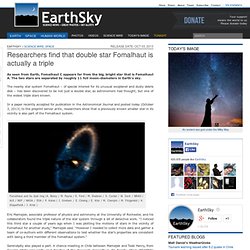
In a paper recently accepted for publication in the Astronomical Journal and posted today (October 3, 2013) to the preprint server arXiv, researchers show that a previously known smaller star in its vicinity is also part of the Fomalhaut system. Fomalhaut and its dust ring (A. Boley / M. Payne / E. Ford / M. Eric Mamajek, associate professor of physics and astronomy at the University of Rochester, and his collaborators found the triple nature of the star system through a bit of detective work.
Serendipity also played a part. By carefully analyzing astrometric (precise movements) and spectroscopic measurements (that allow the temperature and radial velocity to be determined), the researchers were able to measure the distance and speed of the third star. Large Asteroid Belt Discovered Around Multiple-Planet Star System Vega. The data are consistent with both stars having inner, warm belts and outer, cool belts separated by a gap.
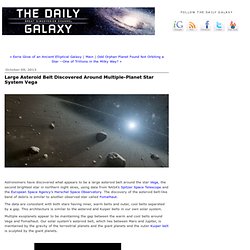
This architecture is similar to the asteroid and Kuiper belts in our own solar system. Multiple exoplanets appear to be maintaining the gap between the warm and cool belts around Vega and Fomalhaut. Intriguing Discoveries About this Most Massive of Nearby Multiple Systems. The nearby star system Fomalhaut – of special interest for its unusual exoplanet and dusty debris disk – has been discovered to be not just a double star, as astronomers had thought, but one of the widest triple stars known.

There are another 11 star systems closer to our Sun than Fomalhaut that consist of three or more stars, including the closest star system, Alpha Centauri. The new measurements also show that the Fomalhaut system is the most massive and widest among these nearby multiple systems. Fomalhaut A is also the 18th brightest star visible in our night sky and one of the few stars with both a directly imaged exoplanet and a dusty debris disk.
The famous star has been featured in science fiction novels by writers Isaac Asimov, Stanislaw Lem, Philip K. Dick, and Frank Herbert. ESO Astronomers Identify Potential Earth-Like Planet in Habitable Zone. Astronomers have discovered a new super-Earth in the habitable zone, where liquid water and a stable atmosphere could reside, around the nearby star HD 40307.
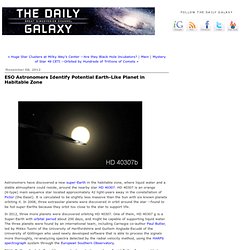
HD 40307 is an orange (K-type) main sequence star located approximately 42 light-years away in the constellation of Pictor (the Easel). It is calculated to be slightly less massive than the Sun with six known planets orbiting it. In 2008, three extrasolar planets were discovered in orbit around the star --found to be hot super-Earths because they orbit too close to the star to support life. "With Guillem Anglada-Escudé's new velocity reduction package," said Butler, "we are able to extract more information from the HARPS spectra, and thus make a more precise measurement. This coupled with the innovative Bayesian orbital searching algorithm, primarily written by Mikko Tuomi, allows us to search deeper into the data and to find smaller Earth-sized planets around the nearest stars. "Mysterious and Intriguing Star System" Observed.
ESA's Herschel space observatory has provided the first images of a dust belt – produced by colliding comets or asteroids – orbiting a subgiant star known to host a planetary system. The team of scientists who made the discovery publishes their results in the Oxford University Press journal Monthly Notices of the Royal Astronomical Society. "It is a mysterious and intriguing system: is there a planet or even two planets sculpting one wide disc, or does the star have a brown dwarf companion that has split the disc in two? " says Amy Bonsor of the Institute de Planétologie et d'Astrophysique de Grenoble, and lead author of the study. As this is the first known example of a subgiant star with planets and a debris disc orbiting it, more examples are needed to determine whether Kappa Cor Bor is unusual or not.
After billions of years steadily burning hydrogen in their cores, stars like our Sun exhaust this central fuel reserve and start burning it in shells around the core. New solar system looks much like home. The star HD 10180 is orbited by up to seven planets in a regular pattern, making it similar to our own solar system Link to video: Is this the biggest extrasolar system yet discovered?

Astronomers have discovered a new solar system 127 light years away that is tantalisingly similar to our own. The team used observations from the European Southern Observatory (Eso) in Chile to find five Neptune-like planets orbiting a Sun-like star called HD 10180 . New Kepler Mission Discovery: Three Earth-size Planets in Habitable Zone. NASA scientists do not know whether life could exist on three newfound planets, but their discovery signals we are another step closer to finding a world similar to Earth around a star like our sun.
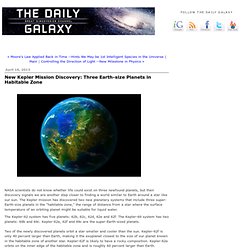
A Watery Solar System Offers Clues to Earth's Creation. If E.T. is out there, it may be a lot easier to find him than we thought — mostly because there are a lot more places for him to live.
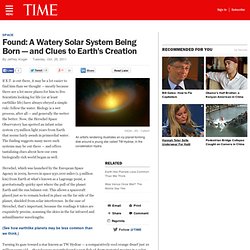
Scientists looking for life (or at least earthlike life) have always obeyed a simple rule: follow the water. Biology is a wet process, after all — and generally the wetter the better. Now, the Herschel Space Observatory has spotted an infant solar system 175 million light years from Earth that seems fairly awash in primordial water. Parallel solar system discovered - Technology & Science. The Kepler-30 solar system has a parent star with three planets in orbital alignment circling it.
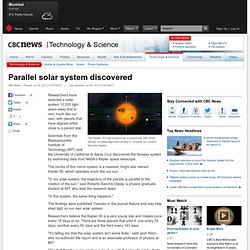
(Graphic by Cristina Sanchis-Ojeda) Researchers have detected a solar system 10,000 light years away that is very much like our own, with planets that have aligned orbits close to a parent star. Scientists from the Massachusetts Institute of Technology (MIT) and the University of California at Santa Cruz discovered the faraway system by examining data from NASA's Kepler space telescope. The centre of this mirror system is a massive, bright star named Kepler-30, which operates much like our sun.